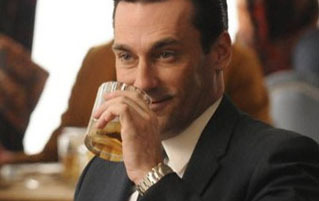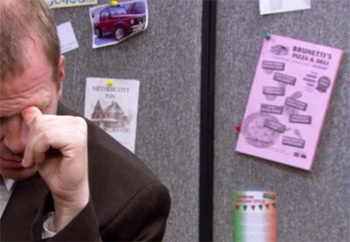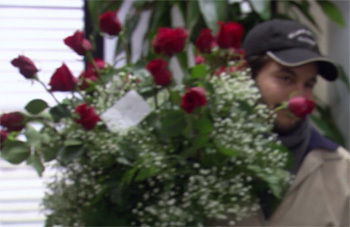6 TV Shows That Put Insane Work Into Details Nobody Noticed

It's fun to poke holes in the plots of movies or TV shows -- that's a big part of our business model. But if we're going to mock the ones who do it wrong, we should take time to give a tip of the hat to the ones who are so obsessive about getting it right. We're not simply talking about making sure nobody on Downton Abbey is seen with a Bluetooth in their ear, either -- this is stuff even the most dedicated fans would need a magnifying glass to catch.
Things like ...
The Clothes in Game of Thrones Tell the Characters' Stories (in Incredible Detail)

Game of Thrones contains some of the most complicated and unpredictable storylines in the history of television, largely because it is based on several thousand pages of painstakingly detailed political fantasy warfare. However, the producers of Game of Thrones have made it so that some of the characters have their arcs literally sewn into their clothing, which admittedly can be easy to miss in a show where everyone is naked all the time.

For example, in season one, Daenerys Targaryen starts out as a timid boner cushion sold to nomadic prince of violence Khal Drogo. However, by season three, Daenerys has transformed into an ass-beating warlord with a massive army and a retinue of freaking dragons, blazing her way through the desert and conquering every city-state she encounters along the way. As Daenerys grows into her role as the warmongering Mother of Dragons, her costume actually becomes more dragon-like:

Costume designer Michele Clapton created a series of seemingly-identical blue dresses for Daenerys to wear throughout seasons three and four, but if you look closely, you can see that the dresses gradually develop embroidered dragon scales. The differences become obvious when you compare the first and last episodes of the third season:

Meanwhile, Sansa Stark has been hit with more terrible bullshit than anyone else on the show, including being betrothed to the sniveling child tyrant who executed her father and being scuttled away to a mountain tower by a sexually predatory pimp/accountant. In fact, so much crap has happened to Sansa that it's hard to keep track of it all, which is probably why the show's producers decided to sew a pictographic recap of her calamitous journey into the wedding dress she wore when she was forced to marry Peter Dinklage, which is the least horrible thing to happen to her thus far.

See that band wrapping around her torso? As it turns out, it's stitched with a mind-boggling series of illustrations that, taken together, trace the dominant forces throughout Sansa's life. It starts at the back with an intertwining of fish and dire wolf, which are the respective symbols of her mother's and father's houses.

As the band winds around her torso, the fish begin to disappear, symbolizing the waning influence of House Tully in the North (and their eventual decimation at the Red Wedding, that thing that the Internet spent an entire summer crying about). Then the wolf meets the Lannister lion, which in the show wound up being less than awesome for Sansa.

The lion begins to dominate the embroidery (sort of like how the Lannisters killed Sansa's father and kept her as a hostage). Pomegranates also begin to dot the embroidery, joining the Lannister colors of red and gold.

Gold: the gold of angry men.
In addition to being red, the pomegranate itself is symbolic -- in Greek mythology, Hades kidnapped Persephone, the daughter of the harvest goddess Demeter, and took her down into the underworld to be his wife. She was allowed to return, provided she didn't eat anything while she was down there, but Hades tricked her into eating pomegranate seeds, dooming her to spend half of every year in Hell for the rest of eternity. It's how the Greeks explained winter (Demeter would spend half the year sulking in depression until Persephone was allowed to return, so everything would be cold and dead while she pouted). Kind of sounds like Sansa being kidnapped by the Lannisters and forced to marry into their family while Winter Is Coming all over Westeros, doesn't it?
Finally, the band connects to the headpiece of her dress, which is completely dominated by the Lannister lion:

When Sansa finally escapes to the Vale, her dress becomes all dark and crow-like, which we think might be hinting towards some future direction for her character. Unless Halloween is really, really long in Westeros, which makes sense, considering all of their seasons last ten goddamned years.

All of that detailed costume work, and millions of people don't even notice it because they happened to be looking down at their burrito during the brief moment it appeared on the screen.
The Zombies on The Walking Dead Decompose Like Real Corpses

Considering The Walking Dead is a show about a bunch of people being pursued across the smashed landscape of post-apocalyptic America by hopeless swarms of reanimated corpses, you'd probably assume that "technical accuracy" wouldn't be high up on the producers' list of priorities. However, practicalities of zombie-ism aside, the show's executive producer, Greg Nicotero, has resorted to some terrifying methods to ensure that all of the shambling ghouls decompose in a realistic way.
Nicotero, who claims to have done extensive research into the various stages of corpse decomposition (presumably in his basement), has the show's makeup team pay special attention to how the zombies' skin has been affected by heat and dehydration, considering that unlike the show's target audience, the undead hordes spend most of their time outside.
Thanks to The Walking Dead's crazy devotion to nightmarish details, the show's prosthetics are also constantly evolving to reflect the gradual decomposition of the zombies as the series progresses. For instance, in the first season, the zombies were relatively fresh-faced (for undead monsters):

As the episodes go on, however, those faces steadily become more disfigured, with the zombies' eyes sinking in and their skin pulling back to tighten around their horrible skulls:



Additionally, compare this video of all the zombie kills in the first two seasons to this one for season three. Notice how later in the series, eliminated zombies fall apart as if they were made out of mashed potatoes and soggy toilet paper, because that's what would happen to six-month-old dead bodies that had been baking out in the humid Georgia heat. So the next time you hear somebody criticizing The Walking Dead for having characters that don't evolve, feel free to correct them. The zombies totally evolve. It's just the humans that don't develop in any meaningful way.
In Mad Men, Even the Ice Cubes Are Historically Accurate

As a show set in the old-timey 1960s, Mad Men makes a concentrated effort towards historical accuracy. The whole time capsule mood would be spoiled if Don Draper were to ride a Segway on screen wearing a Toronto Raptors hat and listening to MC Hammer on his Walkman.

However, the producers of Mad Men aren't content with merely ensuring that everyone's iPhone is turned off and hidden in a desk drawer before the cameras start rolling. They have dedicated their every waking hour to making sure Mad Men is as close a window to the 1960s as we can get without inventing a time machine. For example, there's a crew anecdote about how the show's creator, Matthew Weiner, once ordered several pieces of fruit to be removed from the set because they were too large and shiny.
"Why the hell does that matter?" you're almost certainly asking. Well you see, fruit from the 1960s would be smaller and have much less of a glamorous sheen, because that was before we started injecting all of our crops with bull hormones after inexplicably deciding that the working man of the future needed bigger apples. Weiner couldn't allow the possibility that the fifteen people in the entire freaking world who would've known that would be offended by such a grievous anachronism on display.

Another scene required a can of ham to appear on screen. To make sure that nothing shattered the illusion that the events of Mad Men occurred fifty years ago, prop master Ellen Freund embarked on an epic research expedition to discover a period-appropriate ham of the correct size and shape.
"Well sure!" you might be saying, "Those are things that someone might notice, it makes sense they would do their best to make them accurate." Allow us to challenge that statement with this one: Mad Men goes so far as to make sure the ice cubes in the character's drinks correctly reflect where they are in their forgotten world of the past. See, when a scene is set at a character's home, their drinks will contain large ice cubes, made from vintage metal trays that were found in most households of the time. If the characters are boozing it up in a hotel, the show reaches out to a specialist in L.A. who supplies them with authentic one-inch-square ice cubes that would have been used by businesses back then. Most people would've never even noticed the ice cubes were different sizes, much less whether they were appropriate to the location. Hell, most people never would have noticed there were ice cubes in the scene.

Speaking of ice, Matthew Weiner even makes sure that Mad Men never shows an engagement ring with a cut of diamond that would be out of place in that time period. He even politely requests that the actresses on the show refrain from dieting and exercising, so they keep their historically accurate 1960s curves. Considering that this is a man who obsesses over the size and shape of ice cubes, we're surprised he doesn't tie them down and force feed them Baconators before each shoot.
The Whiteboards in the Background of The Big Bang Theory Are Full of Real Science

The Big Bang Theory has a weird relationship with its audience -- regular people delight in the antics of a bunch of nerdy physicists being terrible at life, while self-described nerds resent it for being the zillionth entry in pop culture history to squeeze blood out of that hackneyed stone. However, that doesn't seem to bother real-life physicists, because the show's producers hired an expert to make sure all of the science is correct. What science, you ask? Literally all of the stuff hiding in the background that you didn't even give a second glance to. Or a first glance.

You missed this shot cause you were grabbing a refill, waiting for the laugh track to end.
We're talking about the whiteboards in the background of Leonard and Sheldon's apartment. Now, if these whiteboards were part of the set dressing of any other show, say Entourage or Murder, She Wrote, they'd be covered with meaningless numbers and barely-disguised penis drawings. However, David Saltzberg, a physics professor at UCLA whom The Big Bang Theory's producers hired as their consulting scientist, makes sure that those whiteboards are always covered in 100 percent accurate, big city book-learnin' science.
For an example of his handiwork, check out the whiteboard on the right:

The egghead jibba-jabba scrawled across that board is describing what happens when you mix iridium with hydrazine (otherwise known as rocket fuel). Later on in the episode, Leonard almost blows everyone up because he makes a mistake trying to reproduce that reaction. So nestled in the background of this single scene, you have both really good science and subtle foreshadowing, which was presumably an exciting Easter egg for the 0.5 percent of the population who could have possibly understood it.
In another episode, Sheldon discusses probability while standing next to a whiteboard outlining Bayes' theorem, which is a major part of probability theory. To balance it out, the rest of the episode is about Sheldon's uncontrollable farting.

Then there's the episode where the gang buys a replica of the time machine from ... um, The Time Machine, while a whiteboard full of equations for theoretical time travel prowls the shadowy landscape behind them, bearing the lonely burden of obscure trivia:

The Startup in Silicon Valley is Financially and Scientifically Sound

HBO's Silicon Valley centers around a loser programmer who inadvertently creates a revolutionary method of compressing data that promises to make him rich beyond his wildest nerd dreams. Because niche shows rarely do well, the producers of Silicon Valley knew they had to draw in both casual sitcom fans and viewers who only enjoy IT workplace comedy when it is laced with textbook science. Luckily, the show strikes a balance between the two demographics by featuring an abundance of masturbation jokes and a technical explanation of the main character's data compressing algorithm that is completely scientifically accurate.
The show hired two engineers from Stanford University, Professor Tsachy Weissman and graduate student Vinith Misra, to create a plausible way for the characters to assess the effectiveness of their made-up technology. And, holy shit, did they succeed -- in fact, the metric that they created was so effective that it could be used to evaluate real-world compression capabilities, not just the carousel of make-believeitude serving as the background for a bunch of dick jokes.
Speaking of which, even the dick jokes are scientifically accurate, which we weren't even aware was a standard you could achieve. For example, in the season finale, the characters try to figure out how long it would take to jerk off a room full of several hundred computer nerds, which, in the spirit of the show's attention to detail, is exactly the type of thing that groups of adults in a professional setting spend their time discussing. However, rather than trusting the meat of the discussion to a room of comedy writers, Silicon Valley's producers took the question to a pair of Stanford mathematicians and had them write a 12-page paper about the scientific principles of masturbating a large group of men, then based the conversation in the show off of their findings.

They even shored up the business aspects of the show. To make sure that the protagonists' company had a viable business model, the producers developed a full portfolio, including their anticipated (though still fictional) go-to-market strategy and (entirely fictional) finances, and presented it to real-life venture capitalists to see whether the company could ever be successful, which apparently it totally could be. At this point, we're amazed they didn't actually create a tech startup instead of just making a show about it.
The Office is Full of Real Local Scranton Products

The Office was a sitcom about broad comedic characters exchanging meaningful looks in the blandest cubicle farm imaginable. The singular nonspecialness of the setting was a major component of the show's comedy -- a bunch of nondescript people working at a paper company in the spectacularly unglamorous town of Scranton, Pennsylvania. To make sure they captured that signature bleak feel as authentically as possible, the set designers worked tirelessly to decorate every inch of The Office with things you would find in an office in Scranton, because viewers needed that heightened sense of realism to truly enjoy Steve Carrell's fever-pitched screaming.
For example, the show's characters are frequently seen drinking Crystal Soda, which is an actual soda produced by the Crystal Soda Water Co of Scranton, PA. Now, The Office was filmed in California, which means the show's producers had to have the soda imported across the entire United States just to have their characters clutch that barely visible piece of geographic trivia:

Similarly, the snack vending machines on the show are stocked with candy bars from Gertrude Hawk, which is a chocolate company that started out in Scranton, despite the fact that those machines could have literally been stuffed with mummified hands as far as the audience was concerned.
On top of that, there are numerous references to legitimate Scranton businesses peppered throughout the background of the show, like a flier for Abe's Deli on the kitchen fridge:

... a takeout menu for Brunetti's Pizza tacked inside Toby's cubicle:

... boxes from Cadden Moving and Storage in the garage of Michael's new home:

... and a sticker for a local radio station:

For the season two episode "Valentine's Day," NBC went so far as to contact a real flower shop in Scranton and have them send a bunch of stuff with their logo on it to be used by a deliveryman on the show. Here is the clearest shot of all that effort we ever get:

Clearly this scene would never have worked with a generic delivery uniform and an iron-on logo printed out from the internet.
For more details you never noticed in media, check out 10 Mind-Blowing Easter Eggs Hidden in Famous Albums and 7 Mind-Blowing Easter Eggs Hidden in Famous Publications.